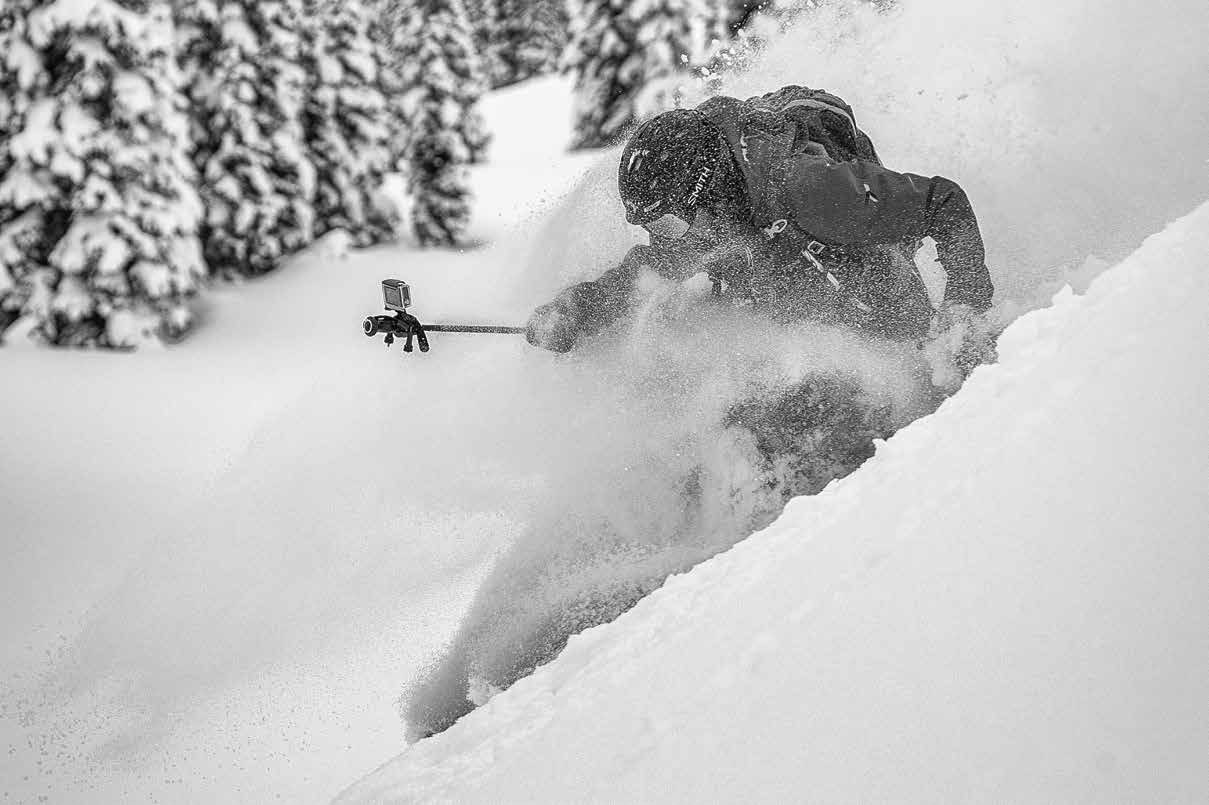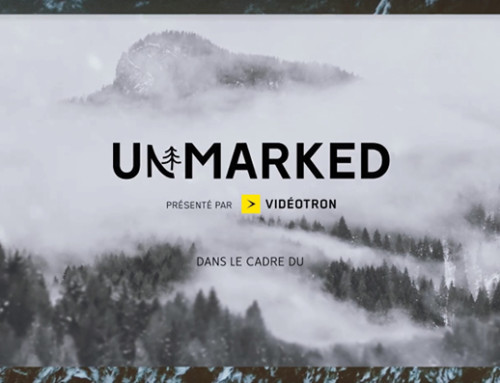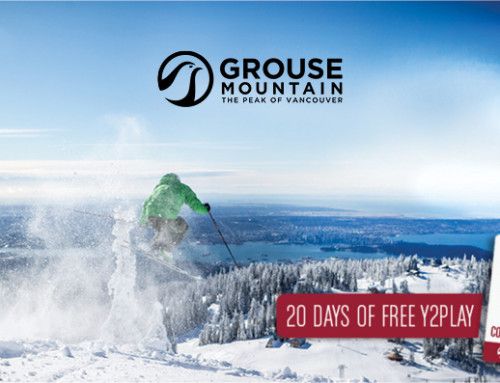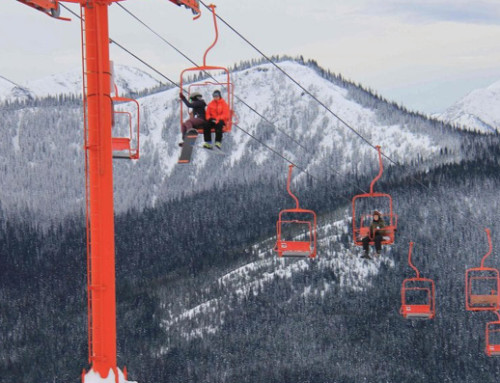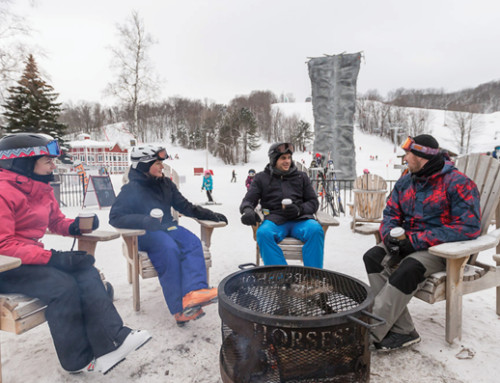Human-powered skiing and “working for your turns” is a superb way to explore the Purcells
BY: Claire Challen PHOTOGRAPHY: Paul Morrison
MOUNTAIN FLOWER FALLS
Alpine Buttercup grew up with t-bars and chairlifts, high-speed and otherwise, to carry her to the top so she could go back down. She’d never known any other way to access the ski trails she so loved – that is, until she grew up and found snow-cats and helicopters to take her to places beyond her wildest imaginings. For years she continued this way, not recognizing the need to change. Exiting the Bell 212 heli that had lifted her to the latest adventure, she was perplexed to see her rotored angel take off and disappear from whence it had come. Breaking the silence only known deep within the mountains, the quickening of Alpine Buttercup’s breath could be heard as she spun around and around, frantically looking for any motorized mechanism to fulfill her desire to ski this remote and pristine terrain. There was no belching diesel, no whining overloaded electric motors, no two-stroke sleds. There was nothing. The silence screamed in her ears as she crumpled to the ground, falling into a blanket of fresh snow that opened its arms and consumed her body within.
LUXURY ECO-PARADISE
Located deep within the Northern Purcell Mountains on the western edge of Glacier National Park, Purcell Mountain Lodge is a smooth 15-minute helicopter flight from the town of Golden, B.C. Breathtaking views of white mountains greet passengers as they fly west from Golden, over Kicking Horse Mountain Resort, trading the noise of town for the stillness of the wilderness. I was heading to the lodge for a four-day ski touring adventure along with my new friends from Whistler, B.C., Derek Foose and Jon Moon.
Set in the gentle alpine terrain of Bald Mountain, Purcell Mountain Lodge welcomes guests to its ski touring heaven with the promise of fresh snow, cozy down comforters and high-class meals. A sauna and showers at the end of the day are luxuries beyond expectation for a location as remote as this, likely spoiling visiting ski tourers, myself included, for anything less. In the 1980s, visionaries Paul Leeson and Russ Younger deduced that skiers, though keen to work for their turns, would ultimately prefer running water and power at the end of the day. A micro-hydroelectric power plant harnesses water from the Spillimacheen River, generating the power that sets Purcell apart from other backcountry touring lodges. An award-winning environmental water treatment system provides the freshest of water with minimal environmental impact.
Early guests of the area, which was initially created with the ski touring traditionalist in mind, spent their evenings in rustic yurt lodgings in a meadow by the Spillimacheen. The lodging location was eventually moved to its present site, straight up Hydro Hill from the power plant. This luxury lodge was built in 1989 with 10 rooms in the main lodge, each aptly named for a mountain flower that blooms for summer guests. I was in the alpine buttercup and Jon and Derek were in the red monkey flower and purple fleabane rooms.
NEW WORLD
The gentle patter of slippered footsteps down the hall and the promise of a classic breakfast of fruit, homemade granola and eggs benedict pulled me from the warmth of my down comforter, and I headed downstairs to join the others. The night before we had perused the maps with our guide, Darrin De Sosa, who would lead us into the most suitable terrain for the weather. Darrin, a Canadian ski guide and certified adventure travel guide who has been guiding for seven years, plays an integral part in the lodge’s success. He’s not only the guide, but the planner, spokesman, kitchen help, and mechanical serviceman here, doing much to keep the lodge running smoothly. He’s also everyone’s hero when there is a rare glitch in the power system, when Darrin can be seen packing toolkit, headlamp and flask before skiing off into the darkness to reset the system. We were delighted to dine at his gourmet restaurant the evening prior to our departure into the backcountry, savouring scallops, salmon and an array of decadent desserts.
None of us had skied in this particular area of the Purcells, but we weren’t entirely devoid of backcountry experience. Derek Foose is the Whistler Freeride Club founder and head coach, and as a coach for Whistler’s Extremely Canadian steeps clinics has been guiding groups all over the world since 2002. Jon Moon, who credits his backcountry awareness to skiing everyday in the vast terrain at Whistler Blackcomb, has coached with Extremely Canadian for the past five years and is a former college racer.
As anyone who has spent time ski touring knows, the choice of companions plays as important a role as your choice of terrain. When inclement weather limits your chance to ski where you’d like, it’s important that your friends can be grateful simply to be in the mountains.
FINDING MY GROOVE
Clack, clack, clack. The rhythmically hypnotic sound of my touring bindings was the only sound except for the occasional birdcall above and sinus-cleansing farmer blow from my compatriots behind me. I allowed myself to move into an almost trance-like state as I followed Darrin’s tracks north toward the Burn. Low cloud had continued to envelope the lodge over breakfast. As we watched, it shrouded not only the mountains but also our hopes of getting up high today. With such uncharacteristically low visibility, we would stay down in the trees to maintain some reference point.
To reach the Burn, we travelled toward the peak of Mount Sir Donald, one of the 50 classic mountains to climb in North America and referred to as the Matterhorn of British Columbia. On the way, we looked down on a zone called the Three Fingers, a series of chutes and ribs of immaculate freshies that hadn’t seen the likes of our Rossignol fleet for quite some time. But it was not to be. There wouldn’t be time enough to ski there today. Leaving such tempting terrain untouched was difficult, and through my own tears I had to endure tortured moans and wounded looks coming from Derek and Jon. However, our tears dried and smiles returned when the Burn proved a worthy jaunt.
After two days of fun in the trees due to the closed skies, we’d hoped the clouds would part on day three and allow us to get up high on the mountain peaks into wide open terrain. We’d even stayed up late working hard on the “drink it blue” premise. Wise skiers have always said if you want the clouds to dissipate, your best option is to stay up late and drink too much; the skies will most definitely reveal the sun the next day. We creatively threw some extreme tobogganing into the mix for good measure.
Rubbing our puffy eyes and tobogganing bruises the next morning, we watched as the day began with teasing glimpses of the easterly peaks of Ptarmigan and Porcupine. But the low cloud was in charge and our efforts were for nought. We would be staying down low again, this time exploring near the lodge. Though of course I was disappointed not to reach the higher elevations, the snow remained dry, light and free from tracks all around us. It was our last day and the crew was keen to make a day of it exploring the short but deep pitches in Knee Grinder Glades.
MAKING A CHANGE
However long I’d held onto the belief that skiing and sweating don’t mix, I realized my mistake over the course of a few days. Exploring the mountains in silence, away from the lift engines and high numbers of skiers that come with lift-accessed skiing, was a draw worthy of testing the wicking capabilities of my base layers. There’s a magic to being outside in the mountains, which of course is magnified ten-fold when the snow is deep and enhanced yet again when that snow is untracked. Yes, I will seek out more human-powered skiing, but I have a few conditions: The company must be worthy. I must be promised untracked snow. And, if I can please shower before my five-star meal, that will suit me just fine.



